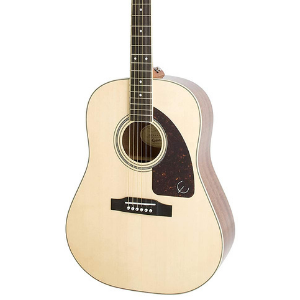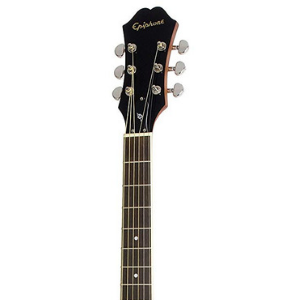- Home
- Instruments
- Gear
- Recording
- Lessons
- Reviews
- Blog


| Body And Neck: |  |
| Hardware: |  |
| Sound: |  |
| Value: |  |
Epiphone makes some of the world's most popular affordable guitars, both electric and acoustic. Since their acquisition by Gibson in 1957, the brand has created budget-friendly spins on legendary guitar designs. Nowadays, the company is producing higher-quality guitars than it has in decades thanks to improvements in Far East manufacturing.
The Epiphone AJ-220S is no exception. Patterned off of Gibson's “jumbo” body shape, this acoustic incorporates Epiphone's “advanced jumbo” styling with quality materials and construction at an extremely affordable price. For less than $300, this instrument is a great entry point into the world of solid-wood acoustic guitars. Let's take a closer look and break down some of the details!
 Body and Neck
Body and NeckThe most notable feature of the AJ-220S is its solid Sitka spruce top. When compared to laminate woods or plywood constructions, solid wood resonates much better and offers a fuller, more distinctive tone. In particular, spruce is known for its clear, punchy articulation and bright top-end. Though this definitely isn't a AAA-grade piece of Sitka, the inclusion of a solid top is still an outstanding feature at this price point.
The rest of the body uses laminated mahogany, while the neck is made of Okume wood glued into a dovetail joint (another feature normally found on more expensive instruments). Similar in color and sound to mahogany and roughly as dense as basswood, Okume is used in both budget and high-end guitars for its distinctive tonal range and light weight.
A rosewood fingerboard adds a bit of warmth along with a smooth feel under the fingers. The SlimTaper neck profile — found on many Gibson acoustics as well as Epiphones — makes the AJ-220S comfortable for a wide range of different players. Even guitarists with smaller hands should have no problems playing this instrument.

While the body and neck offer some touches that you don't normally find on sub-$300 guitars, the hardware setup is much more in line with the rest of Epiphone's budget lineup. The nut and saddle are both made of plastic. This material is common for the price range, but it has a dampening effect on both tone and sustain.
The 1.69″ nut width strikes a comfortable balance between skinny necks (often 1.65″ or narrower) and fat, chunky ones that run up to 1.75″ across. That makes the guitar easy for players of all sizes to strum without sacrificing too much size. Pearloid dots serve as the fretboard inlays, while a set of Epiphone premium nickel tuners sits atop the headstock. These tuners do a pretty solid job of keeping your strings stable, and they look cool as well!
Epiphone has clearly optimized the AJ-220S for rock and country strummers. It projects sound very well, with a loud and present tone that's designed to cut through multiple instruments on stage or in the studio. The solid spruce top helps tighten and sharpen the sound, and it gives this guitar noticeably more resonance than all-laminate competitors.
This axe holds its own for single-note lines and fingerpicking; while it's not the most articulate guitar in the world, it compares well against other jumbo-body acoustics in its price range. String action also plays a significant role in making the guitar sound better for single notes. Epiphone's quality control is strong overall, though some guitars will need more of a setup than others to achieve their best sound.
Part of the appeal of this guitar is the way that the solid top will change in sound as it ages. Every piece of wood is different, but solid wood often “matures” and sounds better with years of use. Unfortunately, it's impossible to evaluate how your specific instrument might sound later in its lifetime, though it's definitely something to consider.
The Epiphone AJ-220S is definitely not a perfect acoustic, though it packs an outstanding amount of quality features into its budget package. When evaluated against its competitors around the $200 mark, this instrument becomes an even more appealing bargain. It would make an outstanding starter acoustic for new players to learn on or a great alternative option for electric players.

Reader Interactions